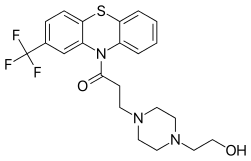|
|---|
| | |
|---|
| | mACh |
- Agonists: 77-LH-28-1
- AC-42
- AC-260,584
- Aceclidine
- Acetylcholine
- AF30
- AF150(S)
- AF267B
- AFDX-384
- Alvameline
- AQRA-741
- Arecoline
- Bethanechol
- Butyrylcholine
- Carbachol
- CDD-0034
- CDD-0078
- CDD-0097
- CDD-0098
- CDD-0102
- Cevimeline
- Choline
- cis-Dioxolane
- Ethoxysebacylcholine
- Itameline
- LY-593,039
- L-689,660
- LY-2,033,298
- McNA343
- Methacholine
- Milameline
- Muscarine
- NGX-267
- Ocvimeline
- Oxotremorine
- PD-151,832
- Pilocarpine
- RS86
- Sabcomeline
- SDZ 210-086
- Sebacylcholine
- Suberyldicholine
- Talsaclidine
- Tazomeline
- Thiopilocarpine
- Vedaclidine
- VU-0029767
- VU-0090157
- VU-0152099
- VU-0152100
- VU-0238429
- WAY-132,983
- Xanomeline
- YM-796
- Antagonists: 3-Quinuclidinyl benzilate
- 4-DAMP
- Aclidinium bromide
- Anisodamine
- Anisodine
- Antihistamines (first-generation) (e.g., brompheniramine, chlorphenamine, cyproheptadine, dimenhydrinate, diphenhydramine, doxylamine, mepyramine (pyrilamine), phenindamine, pheniramine, promethazine, tripelennamine, triprolidine)
- Atropine
- Atropine methonitrate
- Atypical antipsychotics (e.g., clozapine, olanzapine, quetiapine, zotepine)
- Benactyzine
- Benzatropine (benztropine)
- Benzilylcholine mustard
- Benzydamine
- BIBN 99
- Biperiden
- Bornaprine
- CAR-226,086
- CAR-301,060
- CAR-302,196
- CAR-302,282
- CAR-302,368
- CAR-302,537
- CAR-302,668
- CS-27349
- Cyclobenzaprine
- Cyclopentolate
- Darifenacin
- DAU-5884
- Dimethindene
- Dexetimide
- DIBD
- Dicyclomine (dicycloverine)
- Ditran
- EA-3167
- EA-3443
- EA-3580
- EA-3834
- Etanautine
- Etybenzatropine (ethybenztropine)
- Flavoxate
- Himbacine
- HL-031,120
- Ipratropium bromide
- J-104,129
- Hyoscyamine
- Mamba toxin 3
- Mamba toxin 7
- Mazaticol
- Mebeverine
- Methoctramine
- Metixene
- N-Ethyl-3-piperidyl benzilate
- N-Methyl-3-piperidyl benzilate
- Orphenadrine
- Otenzepad
- Oxybutynin
- PBID
- PD-102,807
- PD-0298029
- Phenglutarimide
- Phenyltoloxamine
- Pirenzepine
- Piroheptine
- Procyclidine
- Profenamine
- RU-47,213
- SCH-57,790
- SCH-72,788
- SCH-217,443
- Scopolamine (hyoscine)
- Solifenacin
- Telenzepine
- Tetracyclic antidepressants (e.g., amoxapine, maprotiline, mianserin, mirtazapine)
- Tiotropium bromide
- Tolterodine
- Tricyclic antidepressants (e.g., amitriptyline, butriptyline, clomipramine, desipramine, dosulepin (dothiepin), doxepin, imipramine, lofepramine, nortriptyline, protriptyline, trimipramine)
- Trihexyphenidyl
- Tripitamine
- Tropatepine
- Tropicamide
- Typical antipsychotics (e.g., chlorpromazine, loxapine, thioridazine)
- WIN-2299
- Xanomeline
- Zamifenacin
|
|---|
| | nACh |
- Agonists: 5-HIAA
- A-84,543
- A-366,833
- A-582,941
- A-867,744
- ABT-202
- ABT-418
- ABT-560
- ABT-894
- Acetylcholine
- Altinicline
- Anabasine
- Anatoxin-a
- AR-R17779
- Butinoline
- Butyrylcholine
- Carbachol
- Choline
- Cotinine
- Cytisine
- Decamethonium
- Desformylflustrabromine
- Dianicline
- Dimethylphenylpiperazinium
- Epibatidine
- Epiboxidine
- Ethanol
- Ethoxysebacylcholine
- EVP-4473
- EVP-6124
- Galantamine
- GTS-21
- Ispronicline
- Ivermectin
- Levamisole
- Lobeline
- MEM-63,908 (RG-3487)
- Morantel
- Nicotine (tobacco)
- NS-1738
- PHA-543,613
- PHA-709,829
- PNU-120,596
- PNU-282,987
- Pozanicline
- Rivanicline
- RJR-2429
- Sazetidine A
- SB-206553
- Sebacylcholine
- SIB-1508Y
- SIB-1553A
- SSR-180,711
- Suberyldicholine
- Suxamethonium (succinylcholine)
- TC-1698
- TC-1734
- TC-1827
- TC-2216
- TC-5214
- TC-5619
- TC-6683
- Tebanicline
- Tropisetron
- UB-165
- Varenicline
- WAY-317,538
- XY-4083
- Antagonists: 18-MAC
- 18-MC
- α-Neurotoxins (e.g., α-bungarotoxin, α-cobratoxin, α-conotoxin, many others)
- ABT-126
- Alcuronium
- Allopregnanolone
- Amantadine
- Anatruxonium
- AQW051
- Atracurium
- Barbiturates (e.g., pentobarbital, sodium thiopental)
- Bungarotoxins (e.g., α-bungarotoxin, κ-bungarotoxin)
- Bupropion
- Chandonium
- Chlorisondamine
- Cisatracurium
- Coclaurine
- Coronaridine
- Cyclopropane
- Dacuronium
- Decamethonium
- Dehydronorketamine
- Desflurane
- Dextromethorphan
- Dextropropoxyphene
- Dextrorphan
- Diadonium
- DHβE
- Dihydrochandonium
- Dimethyltubocurarine (metocurine)
- Dipyrandium
- Dizocilpine (MK-801)
- Doxacurium
- Encenicline
- Enflurane
- Esketamine
- Fazadinium
- Gallamine
- Halothane
- Hexafluronium
- Hexamethonium (benzohexonium)
- Hydroxybupropion
- Hydroxynorketamine
- Ibogaine
- Isoflurane
- Ketamine
- Kynurenic acid
- Laudexium (laudolissin)
- Levacetylmethadol
- Levomethadone
- Malouetine
- ME-18-MC
- Mecamylamine
- Memantine
- Methadone
- Methorphan (racemethorphan)
- Methyllycaconitine
- Metocurine
- Mivacurium
- Morphanol (racemorphan)
- Neramexane
- Nitrous oxide
- Norketamine
- Pancuronium bromide
- Pempidine
- Pentamine
- Pentolinium
- Phencyclidine
- Pipecuronium
- Progesterone
- Promegestone
- Radafaxine
- Rapacuronium
- Reboxetine
- Rocuronium
- Sevoflurane
- Surugatoxin
- Thiocolchicoside
- Toxiferine
- Tramadol
- Trimetaphan camsilate (trimethaphan camsylate)
- Tropeinium
- Tubocurarine
- Vanoxerine
- Vecuronium
- Xenon
|
|---|
|
| | | | | |
|---|
| | ChAT |
- Inhibitors: 1-(-Benzoylethyl)pyridinium
- 2-(α-Naphthoyl)ethyltrimethylammonium
- 3-Chloro-4-stillbazole
- 4-(1-Naphthylvinyl)pyridine
- Acetylseco hemicholinium-3
- Acryloylcholine
- AF64A
- B115
- BETA
- CM-54,903
- N,N-Dimethylaminoethylacrylate
- N,N-Dimethylaminoethylchloroacetate
|
|---|
| | AChE | |
|---|
| | BChE |
- Inhibitors: Cymserine
- Many of the AChE inhibitors listed above
|
|---|
|
| | | | |
|
